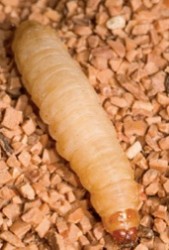
Unlike earthworms, that are crucial to the survival of earth’s plants and trees, wax worms are considered parasites. They infest honeybee colonies where they feed on honey, of course, as well as cast larval skins and pollen. There are four stages of development of the wax worm and moth – egg, larva (waxworm), pupa, and adult or moth. A single female can lay as many as 1,600 eggs. The eggs hatch in about 4 days and the larvae feed for about a month. The milky white to light tan larvae molt or shed their outer covering 7 times. Most of the growth and size increase occurs during the last 2 stages. The process takes about 6 to 7 weeks at 85° to 90° F and high humidity. Full-grown larvae spin a silken cocoon in which the pupal stage is passed.

The adult will emerge from the pupa. Wax worms look like dull white caterpillars. They have thick bodies and a dark head. A look at the shape of the rear margin of the wing will allow you to distinguish between males and females. The female has a relatively straight margin while it is indented or scalloped in males. After mating, the females will lay their eggs and the cycle will begin again.
Although they are considered parasites, man has found several used for wax worms. Wax worms may be raised for fish bait or they can be used for study in biology classrooms.
Wax worms may be found in abundance in honeycombs, they may be purchased from bait companies or biological supply houses, or you can harvest them your own.
According to Lee Townsend, Extension Entomologist at the University of Kentucky College of Agriculture, mature larvae can be harvested at 3-day intervals when they begin to spin cocoons. They readily crawl into pieces of folded paper towels or rolls of corrugated cardboard and spin their silken cocoons. Placing these items in the rearing containers will make it easy to collect and store full-grown larvae.
Two rearing containers will be needed. One for developing larvae and one for the adults to mate and lay eggs. A widemouth glass gallon jar is works for rearing the caterpillars, pint jars are ideal for the adults. Metal containers can be used but wood should be avoided because the larvae can chew through it. Lids or covers should be made with 20-mesh screen to allow some ventilation. After production is underway keep several rearing containers going at once. Wax worms can be safely stored for 2 to 3 months at 60° F and 60% humidity. The temperature in a typical refrigerator is too cold.
The silken cocoons can be removed from mature larvae by agitating them for about 20 minutes in diluted commercial bleach (1 part 5.25% sodium hypochlorite to 5 parts water). After the silk dissolves, the larvae should be rinsed with tap water and dried on toweling before being placed in storage.
A few pupae should be kept at 85° for adult emergence to keep the colony thriving. Place these pupae in a pint container with a strip of dark paper or a strip of wax paper folded like a fan and held with a paper clip. Females will lay their eggs on these strips. The egg papers can be transferred to rearing containers. About 1,000 eggs placed with about 1-1/2 pounds of diet should yield about 500 mature larvae.
Proper cleaning and sterilization of cages will help to reduce disease problem as well as growth of bacteria and fungi. The media can become over grown with these organisms or may become infested with stored product pests such as grain mites. Parasites or diseases may kill developing larvae. Keeping several, rather than one colony, will allow you to discard any in which problems develop without shutting down production. It is best to discard containers with these serious problems rather than attempting to salvage them.
All About Worms is always free, always reader-supported. Your tips via CashApp, Venmo, or Paypal are appreciated! Receipts will come from ISIPP Publishing.






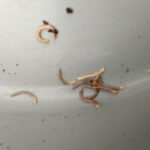
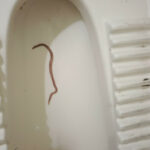
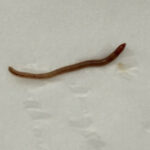


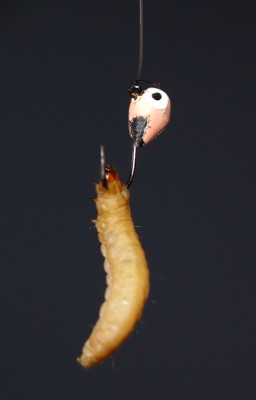





what are the differences between a mealworm and a wax worm